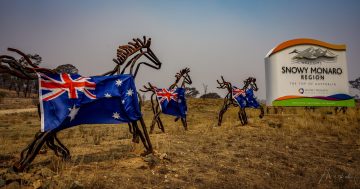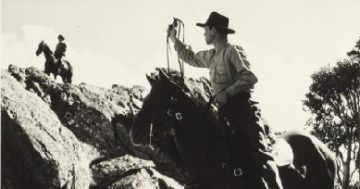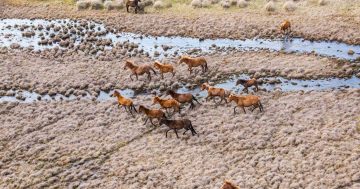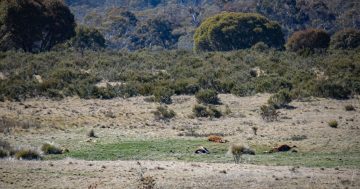
After a seven-month closure, Kosciuszko National Park is now open to the public. But those who visited it at the weekend say it is littered with horse carcasses. Photo: Silver Springs Equine.
WARNING: This article contains images that may distress some readers.
If it wasn’t the sight of horse carcasses that repulsed visitors as they entered Kosciuszko National Park (KNP) when it opened to the public on the October long weekend, it was the smell.
Ian Brown, who has bushwalked through the park clocking up an average 17 kilometres almost daily for 10 years, said the stench was overwhelming.
“I wasn’t sure what to expect after the NSW Government’s action in culling the brumbies up here. But it’s the smell that’s most disturbing,” he said, “because that’s what comes home with you, it gets into your clothes, seems to stay in your nose and only a shower seems to get rid of it.”
He fears the worst is yet to come. With daytime temperatures still in the low teens, he warns the mountains will reek once it warms up and the still intact carcasses start decomposing.
Large sections of Kosciuszko National Park, in the north and south, were closed to the public over a seven-month period from 4 March to 4 October this year as the NSW National Parks and Wildlife Service (NPWS) undertook an aerial shooting program to reduce populations of introduced species including deer, pigs and wild horses, known as brumbies.
Based on an October 2023 population survey, there were between 12,797 and 21,760 wild horses in the park.
By law, NPWS is obliged to reduce the population to 3000 in 32 per cent of the park – in areas associated with wild horse heritage values – by June 2027 to reduce impacts on the park’s fragile alpine and sub-alpine environment.
When traditional methods of culling – bait and trapping, rehoming and ground shooting – failed to meet population control targets, aerial shooting was authorised in October 2023, ending a 23-year ban in NSW.
That ban had been introduced following public backlash after 606 horses were culled in Guy Fawkes River National Park, a handful of those wounded left to die slowly in the days that followed.
The NPWS this week confirmed 8950 horses had been removed from KNP since a Wild Horse Heritage Management Plan was introduced in 2021.
“Of these, 4698 horses were removed during the recent winter closure of the northern section,” a spokesperson said.
This followed a cull of about 1360 horses in southern KNP between November, when aerial culling began, and April 2024.
In July, NSW Environment Minister Penny Sharpe told a NSW Upper House inquiry the cost of the wild horse culling operation to the NSW Government sat at $8.2 million.
The same inquiry, established on 28 August 2023 to inquire into and report on the proposed aerial shooting of brumbies in KNP, saw interrogation of RSPCA responses to aerial shooting standard operating procedures (SOP).
The RSPCA has always maintained aerial culling is less stressful to a horse than rehoming, given culling takes seconds but rehomed horses have to endure trapping and travelling in an enclosed space over a period of time.

Many of the carcasses have been found in heavily vegetated areas of the park. Photo: Silver Springs Equine.
But this has been challenged by local, Rocky Harvey, who rode through the park at the weekend. From what he observed, the wild horses were chased off the vast plains and into the treelines where they were subsequently shot.
“Not a single carcass was spotted in open terrain,” he told Region. “I saw it and everyone else I have heard from found the same – dead horses in the trees – even though it is well documented that open terrain is their preferred habitat.”
Mr Harvey said the NPWS H009 Aerial Shooting SOP was clear; that “chase time should be kept to a minimum” and “chase time is an important contributor to duration of stress”.
“Imagine the terror horses experience being chased by a helicopter for hundreds of metres, maybe thousands, then your family group is picked off one by one,” he said.
“Even if each horse was killed instantly by the first shot, how can it be justified that the chase is humane?”
He maintained the SOP stated NPWS sharpshooters should only shoot when the target area could be clearly seen and “shooters may target the chest and head only”.
“I can’t see how anyone can get a clear line of sight on a horse’s chest unless they’re side-on, not directly above, and how does that happen if the chopper needs to have a safe clearance above trees?” he asked.
Brumby advocates who scoured the park over the three days on foot, horseback and in vehicles, were charged with the grim task of counting the dead. They discovered 374 carcasses, ears removed, some slumped over logs, lying largely under the mountain canopy.
They too believe many of the wild horses were mustered off the plains and into the sights of ground shooters.
Mr Brown claimed most of the carcasses he’d come across since the park officially reopened were littered with bullets way outside the SOP target anatomical zones. Some were heavily pregnant mares.
“You can tell which horses were shot from above because of the wounds on their backs and bums,” he said.
“Some have just one bullet hole in their backs and others you can see the holes in their stomachs and legs and neck, there’s no way these animals haven’t suffered miserable deaths.”
The minister has always maintained the removal of wild horses was made in accordance with the highest possible animal welfare standards and the NPWS undertook to use skilled and competent shooters and appropriate firearms and ammunition in a manner that resulted in the most rapid death possible.
Inquiry chair Animal Justice Party MP Emma Hurst said ever since aerial shooting began, distressed members of the public have contacted her office.
“We’ve received photos of shot horses that are very graphic and disturbing,” she said. “There is no way this could possibly be considered humane.”
She confirmed the five-hearing inquiry had been completed, the draft report was now with the Senate committee and expected to be released in coming weeks.
The NSW RSPCA was contacted for comment but is yet to respond.
The NPWS said the 2024 annual horse population survey would occur across Kosciuszko National Park in October and November. The survey will again involve aerial transects by helicopter with trained observers.
Parts of KNP will be closed for aerial pest control from 11-20 November, but the NPWS confirmed wild horses were not being targeted in the operation.
















